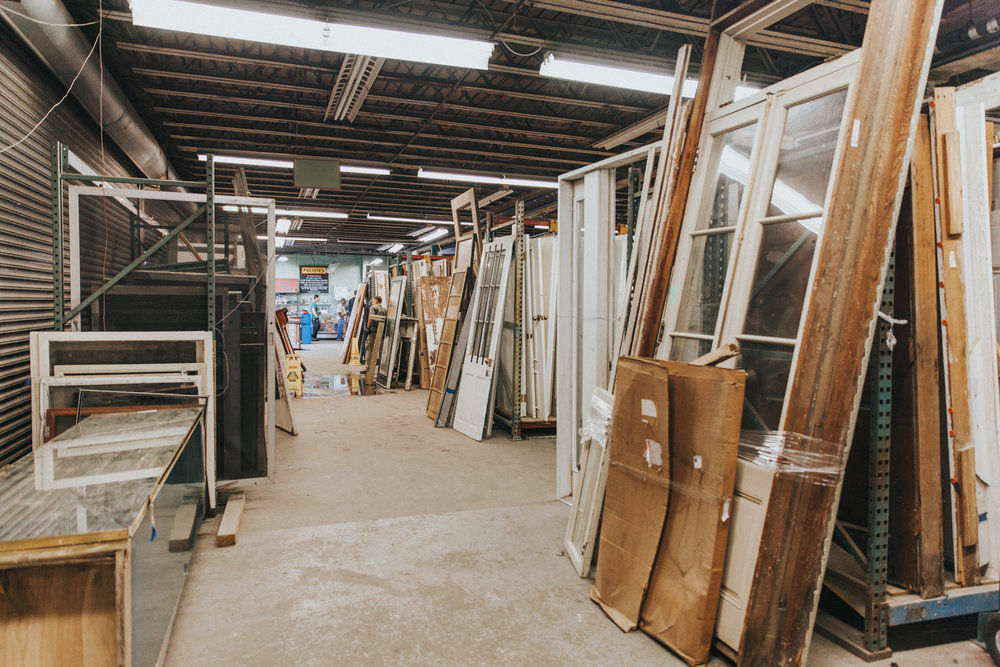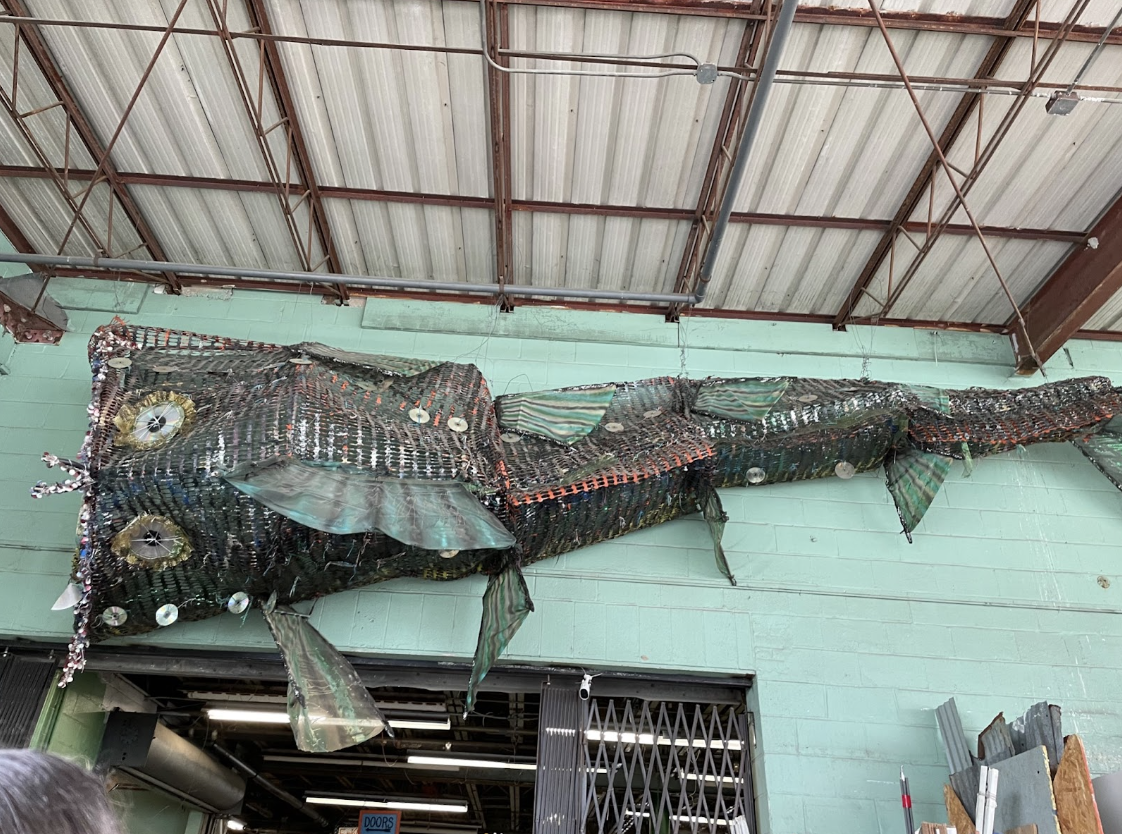By: Jo Walsh, Taylor Golshan, and Maddie SanMarco
Serving the New Orleans community since 1994, The Green Project is a nonprofit organization that has been at the forefront of promoting sustainability and creative reuse. Through its various programs and initiatives, The Green Project encourages individuals and businesses to adopt more eco-friendly practices by repurposing materials that would otherwise end up in landfills.

Why Creative Reuse? Creative reuse, the concept of taking materials and giving them new life in unique and innovative ways, is at the heart of The Green Project’s mission. These materials include old paint, broken car parts, old lampshades, cracked windows, used toilets, and broken doors. While many don’t see value in recyclable waste, The Green Project salvages these items and resells them to the New Orleans community for a reasonable price. Rather than just operating as a salvage store, The Green Project offers free environmental education lessons to teach New Orleans about the role creativity can play in reducing waste in landfills. By empowering people to think creatively and see potential in items that may have been discarded, The Green Project is positively impacting the environment while fostering a sense of community and artistic expression.
Green Project Program Coordinator and Environmental Outreach Leader Erin Genrich shares her passion for creative reuse and her work with The Green Project. “This is a constantly inspiring place to work,” she says, as The Green Project attracts interesting and unique individuals and businesses. Genrich describes how The Green Project has helped build a community of individuals who share a love for sustainability and creativity. She hadn’t always been an advocate for creative reuse. When asked why she joined The Green Project, she said that she was simply looking for an easy job. She mentions “I had been environmentally unaware in that I have always recycled without really thinking about how it’s a privilege.”
After spending some time with the organization, she noticed that several New Orleans schools don’t recycle. She began speaking to and educating schools to encourage students and faculty to participate in eco-friendly behavior. To reinforce what it means to reuse creatively, Genrich invites students to come to The Green Project and explore “The M.E.S.S. Lab” (Materials Exchange & Skill Share), a unique program that promotes creative reuse and encourages individuals to explore their artistic and practical skills. “As a teacher, I want kids to be able to practice what I am talking about,” Erin states. It is a workshop that helps individuals turn salvaged materials into new creations.
In addition to woodworking, metalworking, and sewing classes, the M.E.S.S. Lab also offers a program for mixing old paint. It collects unwanted or used paint from individuals and businesses and processes it into usable paint for sale. The paint is mixed and blended by M.E.S.S. Lab students, who also get to rename and rebrand their new color.

Genrich notes, “All of the mess lab paint sales go directly back into environmental education, so it keeps the program free and sustainable.” Therefore, when someone buys this paint off the shelf of The Green Project, they are supporting environmental education and emphasizing the value of recyclable art. Through this program, The Green Project not only diverts materials from landfills but also provides an opportunity for individuals to connect with like-minded people and express their creativity in a sustainable way.
The Green Project attracts all sorts of creative minds, many of whom need creative advice. In our interview with Genrich, one woman’s story stood out. Recently released from prison, she came to The Green Project in search of an outlet for expression. She found it in constructing a magnificent thirty-foot fish crafted entirely from recycled materials such as caution fencing and CDs. Day and night, she worked on the project that would come to represent her newfound freedom.

When her fish was finally complete, she released her work of art into the Mississippi River, watching as it swam with the currents. Accompanied by a family of alligators, the fish represented not only her creative expression but also her resilience and determination in the face of adversity. The fish and its reptilian entourage made their way back to shore. Unsure of what to do with her piece, The Green Project decided to hang up her creation at their site for all to see, a tribute to her newfound freedom and the transformative power of creative reuse. Visitors to The Green Project marvel over the giant fish and the inspiring story behind it.
The Green Project is more than just a recycling center – it is a hub of creativity, community, and sustainability. Through programs like The M.E.S.S. Lab and Paint Recycling, The Green Project inspires individuals to think outside the box and creatively repurpose materials that would otherwise end up in landfills. By providing access to tools, materials, and education, the organization empowers individuals to take an active role in reducing waste and preserving the environment. The Green Project serves as a source of inspiration for the wider community, highlighting the transformative power of creative reuse and the importance of making sustainable choices. By encouraging and supporting a culture of sustainability, The Green Project is not only positively impacting the local community but also setting an example for the world at large.
For more information, visit:
thegreenproject.org
This piece was edited by Ellery Tripp as part of Professor Kelley Crawford’s Digital Civic Engagement course at Tulane University.
 NOLAbeings Multimedia artist Claire Bangser created NOLAbeings as a portrait-based story project that marries...
NOLAbeings Multimedia artist Claire Bangser created NOLAbeings as a portrait-based story project that marries...  Voodoo in New Orleans: Reviving history: New Orleans fortune telling This article takes a deep dive into the history of Voodoo in New Orleans, its hybridization with Catholicism, and its present-day place in the city's culture. The author visits fortune-tellers in the French Quarter, using their guidance as a tool for introspection rather than a deterministic predictor of the future. Through her experiences in New Orleans, the author feels a mystical connection to both the past and the future.
Voodoo in New Orleans: Reviving history: New Orleans fortune telling This article takes a deep dive into the history of Voodoo in New Orleans, its hybridization with Catholicism, and its present-day place in the city's culture. The author visits fortune-tellers in the French Quarter, using their guidance as a tool for introspection rather than a deterministic predictor of the future. Through her experiences in New Orleans, the author feels a mystical connection to both the past and the future. 